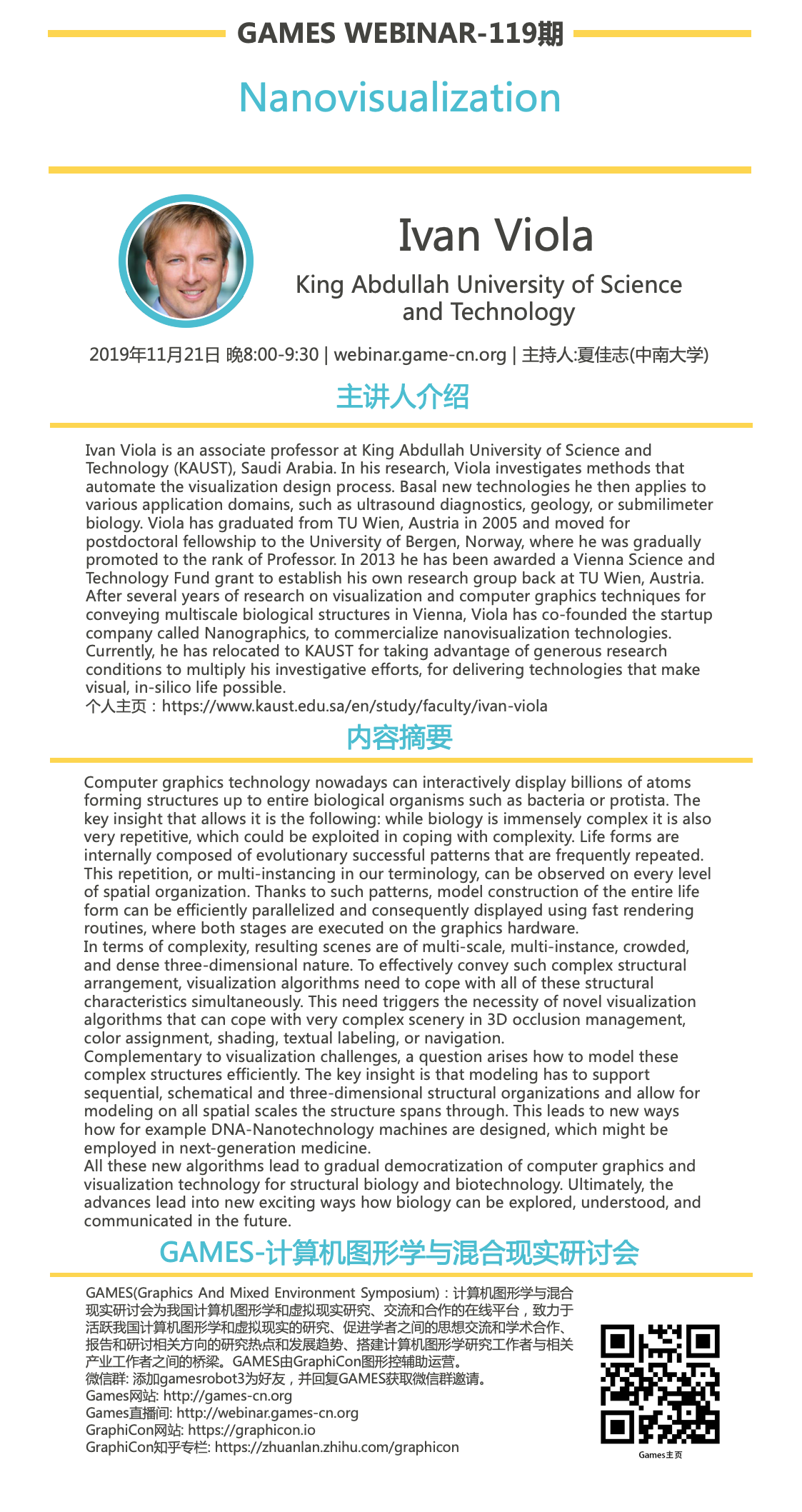GAMES Webinar 2019 – 119期 (可视化前沿技术专题报告)|Ivan Viola ,(King Abdullah University of Science and Technology)

【GAMES Webinar 2019-119期】(可视化前沿技术专题报告)
主持人:夏佳志(中南大学)(个人主页:http://faculty.csu.edu.cn/xiajiazhi/en/index.htm)
报告嘉宾:Ivan Viola,King Abdullah University of Science and Technology
报告时间:2019年11月21日 晚上8:00-9:30(北京时间)
报告题目:
Nanovisualization
报告摘要:
Computer graphics technology nowadays can interactively display billions of atoms forming structures up to entire biological organisms such as bacteria or protista. The key insight that allows it is the following: while biology is immensely complex it is also very repetitive, which could be exploited in coping with complexity. Life forms are internally composed of evolutionary successful patterns that are frequently repeated. This repetition, or multi-instancing in our terminology, can be observed on every level of spatial organization. Thanks to such patterns, model construction of the entire life form can be efficiently parallelized and consequently displayed using fast rendering routines, where both stages are executed on the graphics hardware.
In terms of complexity, resulting scenes are of multi-scale, multi-instance, crowded, and dense three-dimensional nature. To effectively convey such complex structural arrangement, visualization algorithms need to cope with all of these structural characteristics simultaneously. This need triggers the necessity of novel visualization algorithms that can cope with very complex scenery in 3D occlusion management, color assignment, shading, textual labeling, or navigation.
Complementary to visualization challenges, a question arises how to model these complex structures efficiently. The key insight is that modeling has to support sequential, schematical and three-dimensional structural organizations and allow for modeling on all spatial scales the structure spans through. This leads to new ways how for example DNA-Nanotechnology machines are designed, which might be employed in next-generation medicine.
All these new algorithms lead to gradual democratization of computer graphics and visualization technology for structural biology and biotechnology. Ultimately, the advances lead into new exciting ways how biology can be explored, understood, and communicated in the future.
讲者简介:
Ivan Viola is an associate professor at King Abdullah University of Science and Technology (KAUST), Saudi Arabia. In his research, Viola investigates methods that automate the visualization design process. Basal new technologies he then applies to various application domains, such as ultrasound diagnostics, geology, or submilimeter biology. Viola has graduated from TU Wien, Austria in 2005 and moved for postdoctoral fellowship to the University of Bergen, Norway, where he was gradually promoted to the rank of Professor. In 2013 he has been awarded a Vienna Science and Technology Fund grant to establish his own research group back at TU Wien, Austria. After several years of research on visualization and computer graphics techniques for conveying multiscale biological structures in Vienna, Viola has co-founded the startup company called Nanographics, to commercialize nanovisualization technologies. Currently, he has relocated to KAUST for taking advantage of generous research conditions to multiply his investigative efforts, for delivering technologies that make visual, in-silico life possible.
讲者个人主页:https://www.kaust.edu.sa/en/study/faculty/ivan-viola
GAMES主页的“使用教程”中有 “如何观看GAMES Webinar直播?”及“如何加入GAMES微信群?”的信息;
GAMES主页的“资源分享”有往届的直播讲座的视频及PPT等。
观看直播的链接:http://webinar.games-cn.org











